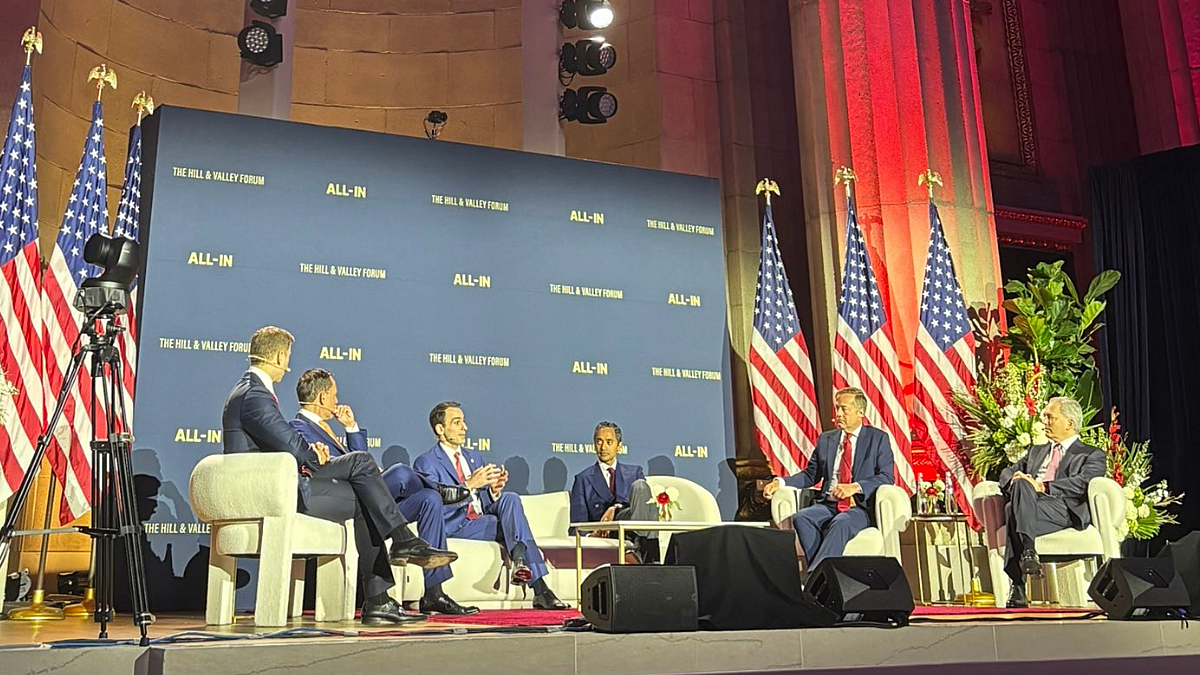Unpacking Trump’s AI Action Plan: Gutting Rules and Speeding Roll-Out
Cristiano Lima-Strong / Jul 23, 2025The article was updated on July 24, 2025, to reflect the release of three Executive Orders related to the action plan.

Michael J. Kratsios, Assistant to the President for Science and Technology, and David O. Sacks, Special Advisor for AI and Crypto, pictured at the Hill and Valley Forum on July 23, 2025. (Source: Office of Science and Technology Policy)
The Trump administration on Wednesday released a long-awaited action plan on artificial intelligence that called for slashing regulations and hastening US deployment of the technology, deepening its split with the Biden administration’s focus on AI safety.
The 28-page roadmap, “Winning the AI Race: America’s AI Action Plan,” recommends a raft of policies spanning federal procurement, research and development, infrastructure, energy, and more. It was accompanied by a trio of executive orders that target “woke” AI systems with “ideological biases,” support the export of a US AI stack overseas, and accelerate data center projects.
The White House billed the plan as a path to “achieve global dominance in artificial intelligence.”
President Donald Trump, who tasked federal agencies with crafting the plan in January, unveiled the actions at an AI summit hosted by venture capitalists later Wednesday.
Here are the topline takeaways from the moves:
Gutting regulations
The White House is directing the Office of Science and Technology (OSTP) and the Office of Budget Management (OMB) to spearhead a major campaign to identify and eliminate regulations across the federal government that could hinder AI development and adoption.
“AI is far too important to smother in bureaucracy at this early stage,” the plan reads.
The plan also urges the Federal Trade Commission (FTC), one of the key federal consumer protection and competition agencies, to revisit and potentially unwind any investigations and legal orders it has already issued that could “unduly burden AI innovation.”
While the FTC has pressed ahead with several blockbuster lawsuits against tech giants, this policy shift could significantly scale back oversight of their growing forays into the AI sector and reduce scrutiny of AI-related harms more broadly.
A soft moratorium on state AI laws
Although Republican lawmakers recently failed to pass a moratorium on state AI laws in Congress, the idea lives on in Washington, including prominently in Trump’s roadmap.
“The Federal government should not allow AI-related Federal funding to be directed toward states with burdensome AI regulations that waste these funds, but should also not interfere with states’ rights to pass prudent laws that are not unduly restrictive to innovation,” the plan states.
To that end, the Trump administration is urging federal agencies that run AI-related programs to “consider a state’s AI regulatory climate when making funding decisions and limit funding if the state’s AI regulatory regimes may hinder the effectiveness of that funding or award.”
The action plan also directs the Federal Communications Commission (FCC) to assess whether state AI rules could get in the way of its enforcement authority.
During his remarks at the AI summit, Trump called for a “single federal standard” to regulate AI, “not 50 different states regulating this industry of the future.”
In lieu of congressional action, the directives could create dozens, if not hundreds, of skirmishes between states looking to pass AI rules and federal agencies.
Culture wars hit AI debate
Trump’s proposals veer into one of the most politically polarizing issues in tech policy, online speech, while also continuing the administration’s attacks on diversity and inclusion initiatives.
One of Trump’s executive orders, titled “Preventing woke AI in the federal government,” directs agencies to only procure “unbiased” AI products that adhere to “ideological neutrality.” The order offers sparse detail on how this will be evaluated, instead tasking parts of the executive branch with issuing guidance on how agencies can comply with it.
The proposals are sure to spark pushback from digital rights groups who have long argued the federal government should not be policing matters of speech online.
The plan also urges the National Institute of Standards & Technology (NIST) to “eliminate references to misinformation, Diversity, Equity, and Inclusion, and climate change” from its AI risk management framework.
While the 2023 framework, implemented under Biden, called for AI decision-making to be “informed by a diverse team” throughout its development cycle, but did not include any explicit mentions of “misinformation,” “disinformation,” “climate,” or “climate change,” according to a review. It did, however, make references to AI’s environmental impact and issues around AI “trustworthiness,” validity and reliability.
In a more bipartisan move, the White House calls on NIST to evaluate LLMs coming out of China to determine if they are in “alignment with Chinese Communist Party talking points and censorship.” The move follows mounting concern in Washington over the growing popularity of Chinese AI providers like DeepSeek.
Speeding government adoption, particularly at DOD
The plan pushes to accelerate the federal government’s own use of AI, especially in the Department of Defense (DOD), and proposes several efforts to achieve that.
Those include the creation of a “talent-exchange program” to more quickly deploy AI expertise across agencies and the development of a new “procurement toolbox” to make acquiring the tools more accessible. The plan also says the government should work to make advanced AI products available to any agencies that think they could benefit from them.
For the DOD specifically, the White House calls for the establishment of an “AI & Autonomous Systems Virtual Proving Ground” to boost in-house expertise and identify workflows that could be automated with AI. It also recommends turning military colleges “into hubs of AI research.”
Easing data center buildout
Expanding US AI infrastructure is one of the document’s three pillars — along with accelerating innovation and leading on international AI diplomacy and security. As such, greasing the wheels for the country’s data center buildout is one of the plan’s core objectives.
To do so, the plan proposes establishing new exclusions from federal environmental laws and using existing programs aimed at expediting permitting to make it easier for AI-related construction projects to break ground.
“America’s environmental permitting system and other regulations make it almost impossible to build this infrastructure in the United States with the speed that is required,” the plan states.
This includes bypassing rules under the National Environmental Policy Act and the Clean Water Act. The plan also calls for “reducing regulations promulgated under the Clean Air Act, the Clean Water Act, [and] the Comprehensive Environmental Response, Compensation, and Liability Act…” to further diminish environmental safeguards in order to fast-track AI-infrastructure deployment.
In addition, the plan recommends making federal lands available for the construction of data centers, including by “directing agencies with significant land portfolios to identify sites suited to large-scale development.”
Trump’s second executive order, “Accelerating federal permitting of data center infrastructure,” launches a new system to “provide financial support” for qualifying data center projects” and takes additional steps to ease permitting, bypass environmental reviews, and make available federal lands.
Finally, in line with the calls to bolster AI adoption in the Defense Department, the plan proposes building new high-security data centers with industry for military and intelligence use.
Countering China on the global stage
The roadmap heavily emphasizes the need to beat China in the AI race, both in terms of the adoption of US technology and the export of “American values” and ideals.
In a section entitled “Lead in International AI Diplomacy and Security,” the Trump administration proposes creating American “full-stack AI export packages,” including hardware, models, software, and more, that could be used wholesale by US allies and trading partners “willing to join America’s AI alliance.”
“The distribution and diffusion of American technology will stop our strategic rivals from making our allies dependent on foreign adversary technology,” the plan states.
Trump’s final executive order, “Promoting the export of the American AI technology stack,” orders the Commerce Department and OSTP to develop an American AI Exports Program to execute the plan.
The action plan also proposes countering China’s influence on global standard-setting bodies, tightening export controls on semiconductor manufacturing (and securing buy-in from allies so they do not “backfill” for China), and building up US leadership in how national security risks in AI models are evaluated.
Authors
